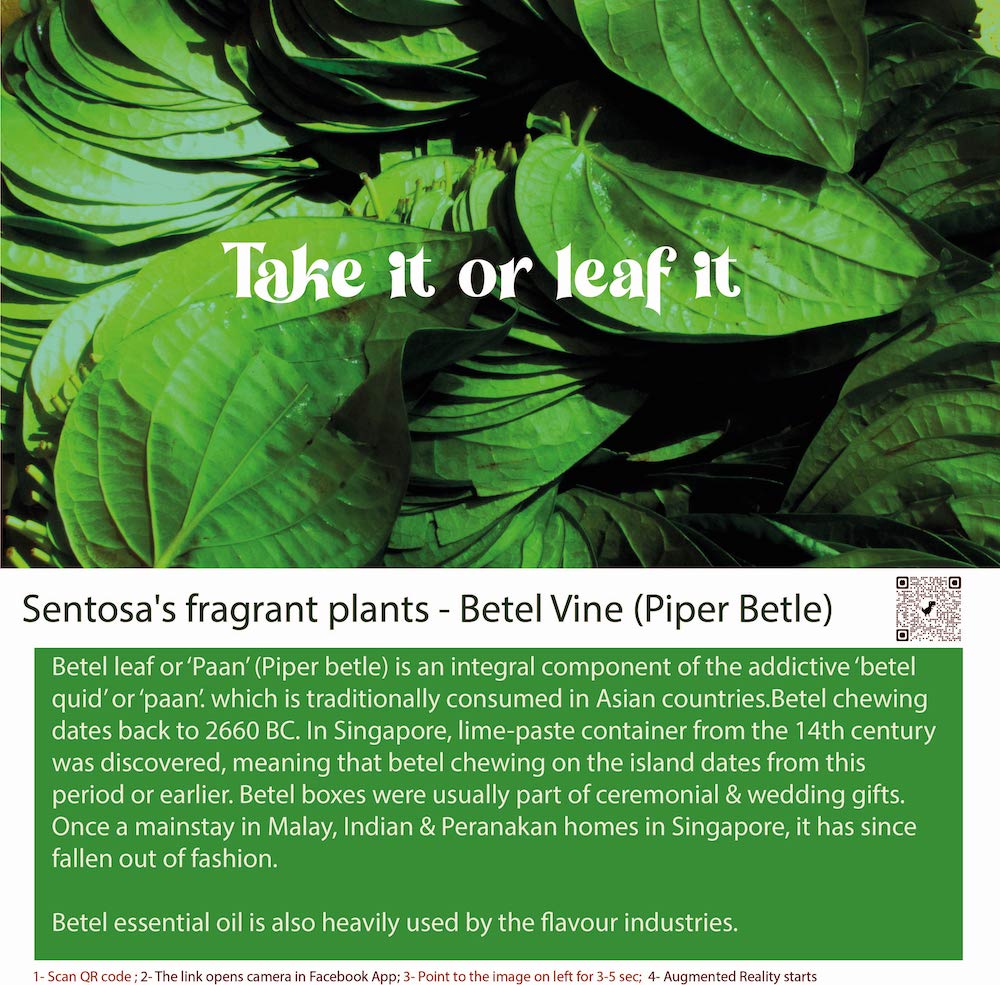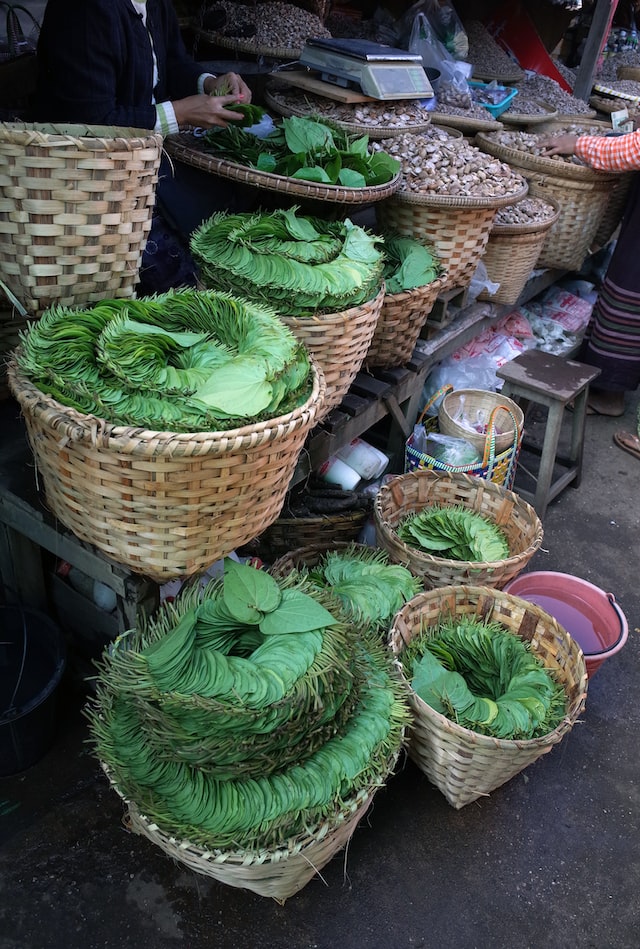Experience the Captivating Fragrance of Betel Vine in Sentosa
Betel Vine: A Multifaceted Wonder Plant
The Betel Vine, scientifically known as Piper betle, is a climbing plant that has captivated cultures across Asia for centuries. This evergreen vine is renowned for its cultural significance, culinary uses, therapeutic properties, and intriguing history. From its role in perfumes and fragrances to its traditional medicinal applications, the Betel Vine remains an integral part of many communities, making it a multifaceted wonder plant with a fascinating story to tell.
Cultural Significance and Culinary Uses:
The Betel Vine holds deep cultural significance in various Asian countries, including India, Bangladesh, Sri Lanka, Thailand, and Indonesia. It is closely associated with customs and rituals, often used in religious ceremonies and traditional practices.
One of the most well-known uses of the Betel Vine is the preparation of betel quid, a popular chew made by wrapping areca nut, slaked lime, and sometimes tobacco in betel leaves. Betel quid chewing is a centuries-old tradition, often associated with hospitality and social gatherings. The practice of betel chewing has become an essential part of cultural heritage in many Asian communities.
Medicinal Benefits and Therapeutic Oils:
In traditional medicine, the Betel Vine has been valued for its medicinal properties. Betel leaves are believed to have antiseptic, analgesic, and anti-inflammatory properties. They are used in various forms, such as infusions, poultices, and oils, to treat ailments like coughs, wounds, and skin infections.
Therapeutic oils derived from the Betel Vine are also utilized in aromatherapy and alternative medicine practices. The essential oil of the Betel Vine is known for its calming and relaxing effects, making it a valuable component in stress relief and mood-enhancing therapies.
History and Traditional Practices:
The history of the Betel Vine can be traced back to ancient times when it was considered a sacred plant and used in religious ceremonies. Over the centuries, the practice of betel chewing evolved into a symbol of social bonding, often exchanged as a token of friendship and goodwill.
In many cultures, betel chewing is a rite of passage for various social events, including weddings and festivals. The preparation and presentation of betel quid became an art form, with different communities developing unique variations of the recipe, incorporating diverse ingredients to enhance its flavor and medicinal value.
Betel Vine in Perfumes and Fragrances:
Betel leaves have a distinct and pleasant aroma, with a peppery and slightly sweet note. The fragrance of betel leaves has inspired perfumers to include it in various fragrances and perfumes. When combined with other floral or woody notes, the betel leaf adds a unique and exotic twist, creating captivating scent compositions.
Fun Crazy Facts about Betel Vine:
The Betel Vine is much more than a simple climbing plant; it holds a rich cultural history, culinary significance, and diverse medicinal properties. From its role in traditional practices and religious ceremonies to its presence in perfumes and fragrances, the Betel Vine remains deeply rooted in the fabric of Asian cultures.
While the betel quid chewing tradition continues to be embraced by many, the medicinal applications and therapeutic oils derived from the Betel Vine showcase its potential for holistic healing and wellness. As the Betel Vine continues to weave its way through the cultural tapestry of Asia, its multifaceted nature as a wonder plant will continue to captivate and intrigue generations to come.
The Betel Vine, scientifically known as Piper betle, is a climbing plant that has captivated cultures across Asia for centuries. This evergreen vine is renowned for its cultural significance, culinary uses, therapeutic properties, and intriguing history. From its role in perfumes and fragrances to its traditional medicinal applications, the Betel Vine remains an integral part of many communities, making it a multifaceted wonder plant with a fascinating story to tell.
Cultural Significance and Culinary Uses:
The Betel Vine holds deep cultural significance in various Asian countries, including India, Bangladesh, Sri Lanka, Thailand, and Indonesia. It is closely associated with customs and rituals, often used in religious ceremonies and traditional practices.
One of the most well-known uses of the Betel Vine is the preparation of betel quid, a popular chew made by wrapping areca nut, slaked lime, and sometimes tobacco in betel leaves. Betel quid chewing is a centuries-old tradition, often associated with hospitality and social gatherings. The practice of betel chewing has become an essential part of cultural heritage in many Asian communities.
Medicinal Benefits and Therapeutic Oils:
In traditional medicine, the Betel Vine has been valued for its medicinal properties. Betel leaves are believed to have antiseptic, analgesic, and anti-inflammatory properties. They are used in various forms, such as infusions, poultices, and oils, to treat ailments like coughs, wounds, and skin infections.
Therapeutic oils derived from the Betel Vine are also utilized in aromatherapy and alternative medicine practices. The essential oil of the Betel Vine is known for its calming and relaxing effects, making it a valuable component in stress relief and mood-enhancing therapies.
History and Traditional Practices:
The history of the Betel Vine can be traced back to ancient times when it was considered a sacred plant and used in religious ceremonies. Over the centuries, the practice of betel chewing evolved into a symbol of social bonding, often exchanged as a token of friendship and goodwill.
In many cultures, betel chewing is a rite of passage for various social events, including weddings and festivals. The preparation and presentation of betel quid became an art form, with different communities developing unique variations of the recipe, incorporating diverse ingredients to enhance its flavor and medicinal value.
Betel Vine in Perfumes and Fragrances:
Betel leaves have a distinct and pleasant aroma, with a peppery and slightly sweet note. The fragrance of betel leaves has inspired perfumers to include it in various fragrances and perfumes. When combined with other floral or woody notes, the betel leaf adds a unique and exotic twist, creating captivating scent compositions.
Fun Crazy Facts about Betel Vine:
- Betel quid chewing is often considered a mild stimulant, providing a sense of alertness and mild euphoria.
- In some cultures, betel chewing is believed to symbolize love and affection.
- The Betel Vine belongs to the Piperaceae family, which also includes the Black Pepper plant (Piper nigrum).
- In some Asian communities, the betel quid is offered to guests as a gesture of hospitality.
The Betel Vine is much more than a simple climbing plant; it holds a rich cultural history, culinary significance, and diverse medicinal properties. From its role in traditional practices and religious ceremonies to its presence in perfumes and fragrances, the Betel Vine remains deeply rooted in the fabric of Asian cultures.
While the betel quid chewing tradition continues to be embraced by many, the medicinal applications and therapeutic oils derived from the Betel Vine showcase its potential for holistic healing and wellness. As the Betel Vine continues to weave its way through the cultural tapestry of Asia, its multifaceted nature as a wonder plant will continue to captivate and intrigue generations to come.
To experience augmented reality, please open the Facebook-app using QR code and point to the image below
Introducing Our Sentosa Collection: Betel Vine Local Perfume
Betel vine (Piper betle) is a tropical climbing vine that is native to Southeast Asia , including Singapore and is widely cultivated in many parts of the world for its leaves, which are used to make a popular stimulant chew called betel quid or paan. The betel vine is a member of the pepper family and grows well in hot, humid climates with plenty of sunlight.
The leaves of the betel vine are glossy green and heart-shaped, and they have a slightly pungent and spicy aroma. When chewed, the leaves release a reddish juice that acts as a natural stimulant, similar to caffeine. Betel quid is often made by wrapping a small piece of areca nut, a type of nut from the areca palm, and a pinch of lime powder in a betel leaf, which is then folded and chewed.
The leaves of the betel vine are glossy green and heart-shaped, and they have a slightly pungent and spicy aroma. When chewed, the leaves release a reddish juice that acts as a natural stimulant, similar to caffeine. Betel quid is often made by wrapping a small piece of areca nut, a type of nut from the areca palm, and a pinch of lime powder in a betel leaf, which is then folded and chewed.
Unveil the Aromatic Wonders of Betel Vine Fragrance
Betel quid is a popular traditional chew in many parts of the world, particularly in South and Southeast Asia, and it is often used as a social and cultural activity. Some research has suggested that betel quid may have some potential health benefits, but it can also have negative effects on health when consumed in large amounts or over long periods of time, as it may increase the risk of oral cancer and other health problems.
Crafting Memories with Sentosa's Betel Vine Perfume
Betel sweets are a type of confectionery made with betel leaves, which are commonly used to make the stimulant chew called betel quid or paan. Betel sweets are a traditional snack in many parts of the world, particularly in South and Southeast Asia, and they are often served as a social and cultural activity. To make betel sweets, the betel leaves are typically softened and sweetened with sugar, honey, or other sweeteners, and then shaped into various forms, such as balls, tubes, or cones.
Embrace the Essence of Sentosa with Scentopia
The betel sweets may also be flavored with various spices and herbs, such as cardamom, clove, or rose petals, to give them a unique taste and aroma. Betel sweets are usually consumed as a mouth freshener or digestive after a meal, and they are often served at special occasions, such as weddings and festivals. While betel sweets may have some potential health benefits when consumed in small amounts, they can also have negative effects on health when consumed in large amounts
Scented Souvenirs: Take Sentosa's Fragrance Home
Betel oil is an essential oil that is extracted from the leaves of the betel vine (Piper betle), a tropical climbing vine that is native to Southeast Asia and is widely cultivated for its leaves, which are used to make a popular stimulant chew called betel quid or paan. The betel vine is a member of the pepper family and grows well in hot, humid climates with plenty of sunlight. Betel oil is obtained by steam distillation of the fresh or dried leaves of the betel vine, and it has a pale yellow to yellowish-brown color and a spicy, pungent aroma.
Betel Vine Local Perfume
Betel oil has a variety of uses in traditional medicine and cosmetics. It is used in aromatherapy and massage therapy to help relax the mind and body, and it is believed to have anti-inflammatory and analgesic (pain-relieving) properties. Betel oil is also used in the manufacturing of fragrances, soaps, and other personal care products, and it is said to have skin-toning and astringent properties.
Join Scentopia, Sentosa's latest tourist attraction wonderful orchid scent crafting, fragrance tour, bridal shower or corporate team building which includes perfume making onsite and offsite, beach activities and more. We also serve primary school learning journey, secondary students and pupil on industrial excursions. Know more about our orchids perfume bar or therapeutic orchid scents and other wellness aromas. Conatct Perfume workshop or book a scent crafting session here.






